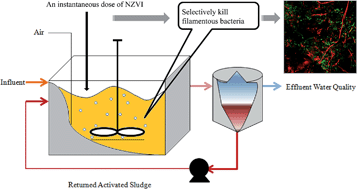Filamentous sludge bulking control by nano zero-valent iron in activated sludge treatment systems†
Abstract
Sludge bulking causes loss of biomass in the effluent and deterioration of effluent water quality. This study explored the use of nano zero-valent iron (NZVI with an average particle size of 55 ± 11 nm) for sludge bulking control. In two Modified Ludzack–Ettinger (MLE) activated sludge treatment systems, a single dose of NZVI at the final concentration of 100 mg Fe per L in the mixed liquor reduced the number of filamentous bacteria Type 021N by 2–3 log units (a reduction of 99.9 and 96.7% in MLE tank #1 and #2, respectively). The side effect of the use of NZVI depended on sludge bulking conditions and biomass concentration. In the system with sludge bulking and significant sludge loss (average biomass concentration of 1022 ± 159 COD mg per L or at the ratio of 0.098 g Fe per g biomass COD), the use of NZVI increased effluent COD, NH4+–N and NO2−–N concentrations, as also evident with the loss of nitrifying populations and nitrifying activities resulting in more than 40 days to have the full recovery of the activated sludge system. In contrast, in the system with the early stages of bulking and the biomass concentration of 1799 ± 113 COD mg per L (at the ratio of 0.056 g Fe per g biomass COD), the effluent water quality and overall bioreactor performance were only slightly affected for a few days.


 Please wait while we load your content...
Please wait while we load your content...